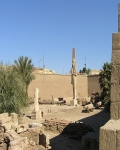Akhmim
Archaeology »
Archaeological Monuments » Akhmim
Akhmim - Egypt
Akhmim is located in Sohag.
Akhmim monument was established on 1981.
Primary threats to Akhmim :
- In pharaonic times it was also known as Khent-Min, being the cult centre of the god Min.
- Flourished was the capital of the 9th Upper Egyptian Nome in the Ptolemaic Period.
Historical facts of Akhmim :
- Akhmim, also known as Ipu, is an ancient city located on the east bank of the Nile River in Upper Egypt. With a history dating back over 4,000 years, Akhmim has witnessed the rise and fall of several civilizations, leaving behind a rich tapestry of historical facts and cultural significance.
- One of the most notable aspects of Akhmim's history is its position as a major religious center. In ancient times, the city was revered as the capital of the ninth nome (administrative division) of Upper Egypt and was dedicated to the worship of the fertility god Min. Akhmim was also associated with the goddess Meretseger, who was believed to protect the Theban Necropolis.
- Akhmim's strategic location along the Nile River made it an important trading hub throughout history. It served as a link between Upper and Lower Egypt, facilitating the exchange of goods and ideas. The city prospered economically and culturally, attracting merchants from various regions.
- The archaeological remains in Akhmim provide valuable insights into the city's past. The Akhmim Codex, a Coptic manuscript discovered in the late 19th century, contains a collection of Christian texts and has provided valuable information about early Christian communities in the region. The site also boasts ancient temples, including the Temple of Min, which was dedicated to the city's patron deity.
- Throughout its long history, Akhmim endured various invasions and conquests. It was conquered by the Persians, Greeks, and Romans, each leaving their mark on the city's cultural landscape. The Roman period witnessed the construction of grand buildings and the flourishing of art and literature.
- Today, Akhmim is a bustling modern city that blends its ancient heritage with contemporary life. It continues to be an important center for the textile industry, known for its production of high-quality textiles and embroidered fabrics.
- In summary, Akhmim stands as a testament to Egypt's rich historical legacy. Its role as a religious center, trading hub, and archaeological site highlight its cultural significance. As visitors explore the city's ancient temples and artifacts, they are transported back in time, discovering the stories of the civilizations that once thrived in this remarkable city on the banks of the Nile.

